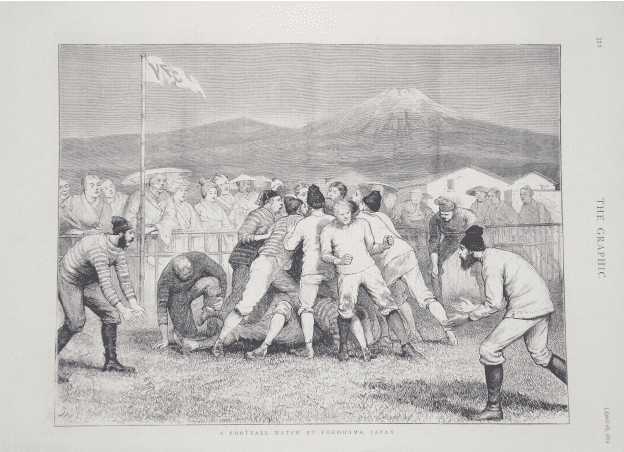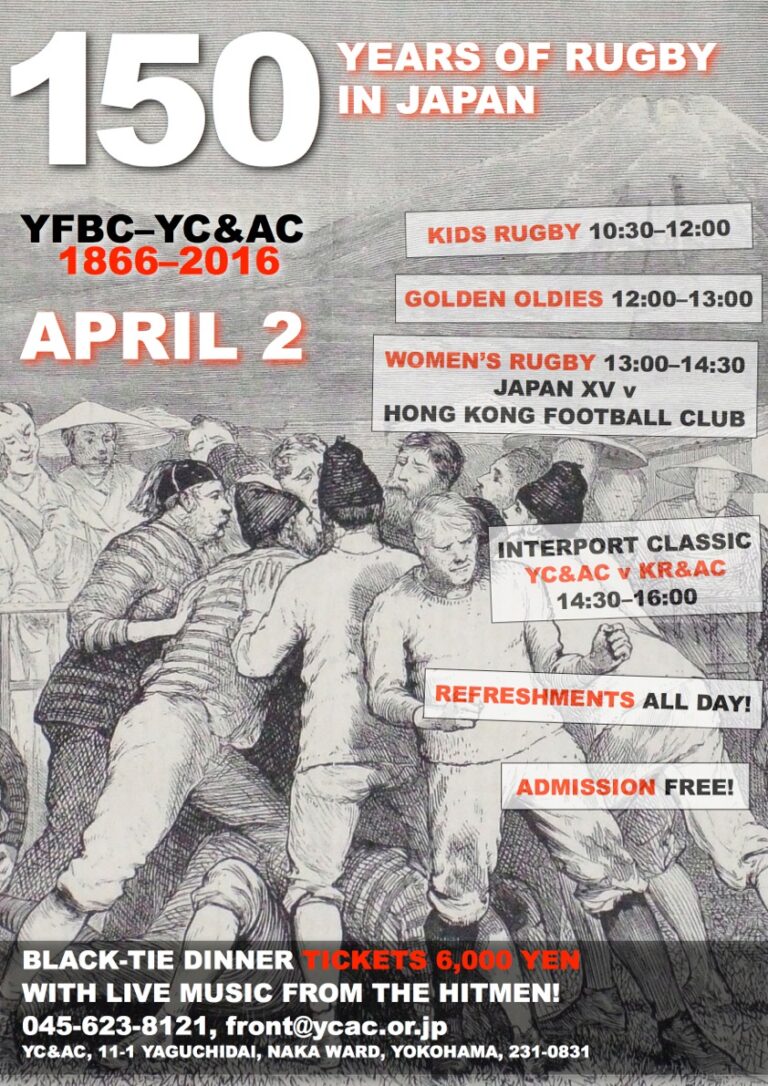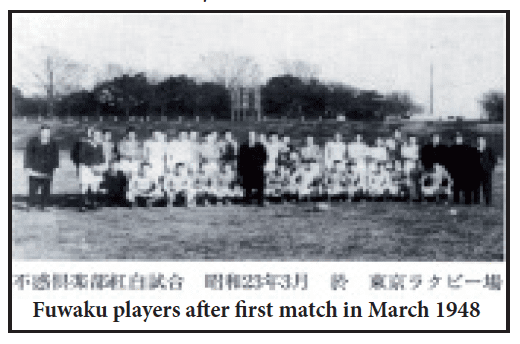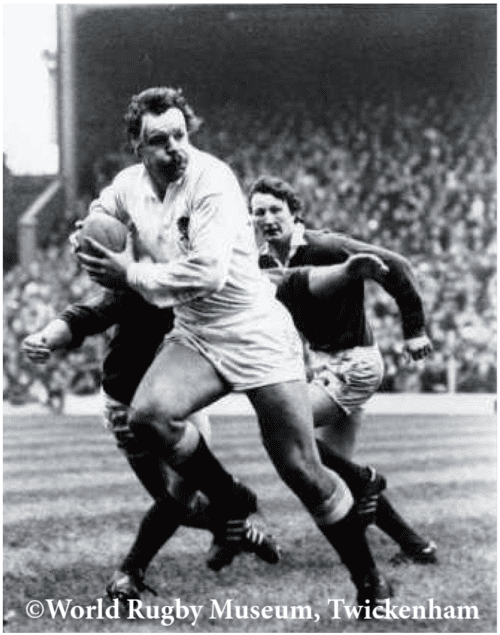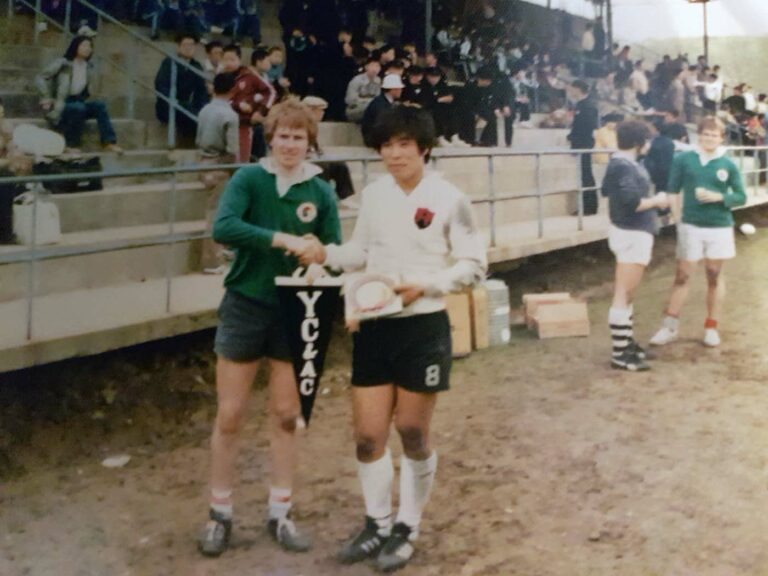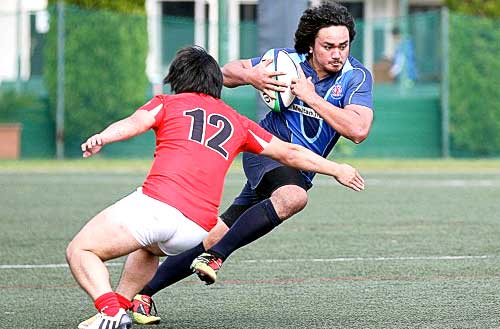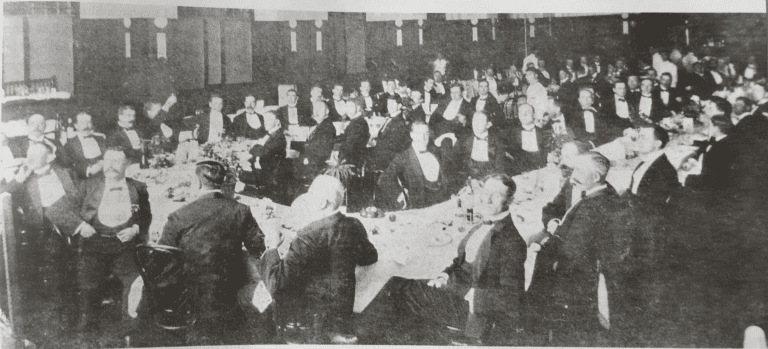THE 1874 “FOOTBALL IN YOKOHAMA” ILLUSTRATION AND THE ARTIST WHO CREATED IT

The above is the full-page illustration in the April 18 issue of the illustrated news magazine called The Graphic which was published in London. The Graphic was the main rival publication of the London Illustrated News whose source of illustrations relating to Japan was Charles Wirgman. Wirgman himself unfortunately detested ‘football’ as being “emphatically a game of savages.”
Several hundred thousand copies of the Graphic were sold worldwide at the time. In addition, the image was also published in the US by Harper’s Weekly, which also had a very large circulation, in their May 3 issue of the same year.
The image is most likely the oldest image of rugby in Asia and one of the very oldest in the world relating to ‘club’ football – at glance at the picture will tell you that the players were certainly not playing a game of soccer – actually being played as opposed to football/rugby played in schools and universities. The image provides clear evidence about the kind of football being played in Yokohama in the 1870s and the very visible flag with the four letters YF(possibly the letter B was hidden in a furl of the flag?) and C on it shows that the Yokohama Foot Ball Club was still surviving while the number of spectators suggests the sport was thriving. The game was played on the ground of the Yokohama Cricket Club(YCC) which had an agreement with the YFBC and also the Yokohama Base Ball Club by which they paid annual fees to use the cricket ground. This came about because while the footballers and baseball players didn’t worry much about the quality of the surface on the ground on which they played as long as it was more or less flat, the cricketers like YCC founder J. P. Mollison wanted to the wicket area of the ground to be of the best possible quality even if it meant importing turfed from the home country and so they leased the land from the government. The hints that when the football club used the grpund they put their flag up the flagpole.
the image in the Graphic magazine was entitled ‘A Football Match at Yokohama, Japan’ and had a kind of caption on a different page with the following words: “WHEREVER they go the English cling to their national peculiarities with remarkable tenacity, and whether John Bull settles in the polar regions of thick-ribbed ice, or under the blazing sun of the tropics, or in the more temperate regions which by comparison resemble his own misty island, he carries with him a passion for plum pudding, pale ale, cold baths, horse-racing, cricket, croquet, and newspapers. There is a British colony at Yokohama, Japan, and they have introduced the mysteries of football into the Far East, as is shown by our engraving, which is from a sketch by Mr. H. A. Abell, of the London Chartered Bank in that city. The Japanese are a go-a-head race, the Government has introduced all sorts of European innovations with what appears to us impolite rapidity, but we are not yet aware they have issued an edict compelling every male over sixteen to join an athletic club, and exhibit his prowess at least twice a year at a local Lillee Bridge, under the shadow of the lovely snow-mountain Fujiyama.”
The words “There is a British colony at Yokohama, Japan, and they have introduced the mysteries of football into the Far East” rather strongly supports Yokohama’s claim to be the location of Asia’s first rugby club. However, the editor seems to be mainly philosophically waffling writes nothing about the actual game illustrated. It would seem that the editor of the magazine was interested in the fact that the cricket ground in Yokohama hinted that it had potential to be a “local Lillee Bridge.” Lillee Bridge will mean nothing to readers but in the late 1860s and early 1870s the Lillee Bridge Grounds was a famous multi-sport ground in West Brompton in London used for football, cricket, athletics, cycling and even boxing. The second ever F.A. Cup (soccer) in 1873 was played there and the first ever amateur under the Queensbury Rules was also held there. The Marylebone Cricket Club used it as its home ground before moving to Lord’s. However, the grounds fell into disuse after a riot in 1887 and were formally closed in 1888. I suggest that the fact that this football match was played on the cricket ground in Yokohama inspired the editor to imagine it might become a multi-sport ground even forJapanese people.
The editor of Harper’s Weekly takes some very different angles on the illustration and shows more interest in the game itself. The title of the illustration is “Foot-ball In Japan” and his caption reads: “This sketch represents a foot-ball match between Englishmen and Scotchmen near the city of Yokohama in Japan. A party of Japanese men and women are interested spectators of the game. They probably wonder what fun there can be in kicking about a big ball and getting hot and tired over it, and whether it wouldn’t be more rational to hire players and enjoy their sport as spectators, like themselves, as some great Eastern potentate is said to have expressed surprise, on first seeing a European ball, that servants were not required to do the dancing for their masters. He thought such an arrangement would be vastly more sensible and dignified than for great lords and ladies, and even princes and princesses, to go skipping, hopping, and whirling about the room. But European and American ideas of amusement differ essentially from Eastern notions, and we should probably find our Englishmen and Scotchmen entirely unwilling to change places with their Japanese spectators.”

The caption with Harper’s version of the image states that the game was between “Englishmen and Scotchmen” The local newspapers carried reports on two games played in late 1873 that were basically “England Vs Scotland” and so I believe the football match one of these, possibly the first one. Abell wrote that the game was the first game of football played in Japan which it clearly wasn’t. Maybe, playing on the England Scotland rivalry, it was the first match in Japan to draw quite a lot of spectators. The caption in the Graphic to the ‘Football Match at Yokohama, Japan’ image refers to Abell but got his initials wrong (“H.A.” when they were “H. F.”) which made it difficult to find out about him. The Harper’s Weekly image does not mention the artist.
THE ARTIST BEHIND THAT 1874 ILLUSTRATION
Henry Francis Abell was born in January 1851 in St. James in central London. He was the eldest of five sons born to Henry Gilmore Abell and his wife Sophia W. Henry Gilmore Abell was a successful gold bullion dealer who became the main partner of Stewart Pixley and formed Pixley & Abell, one of the five partnerships/companies that controlled the London bullion market for over 100 years until 1957. Henry Francis was brought up in Sydenham in Kent and retained a great passion for the county of Kent throughout his life writing three volumes on the history of the county.
From the age of eight he was sent to boarding school in Blackheath. In the world of rugby Blackheath is known as one of the original homes of rugby football because both Blackheath Propriety School and Blackheath Football Club, which was founded by old boys of the school, both attended and walked out of the founding of the Football Association in 1863 .
Blackheath Proprietary was not the only school in Blackheath. In Eliot Place there were several boarding schools that bore the names of their headmasters. Abell went to the most famous of those – Powles’ School which became Nunns’ School in 1865 when its headmaster and owner changed. At school he had to play football and he found that the neighbouring schools in Eliot Place were much tougher opposition that Blackheath Proprietary.
Henry Abell was to become an excellent artist with the Graphic publishing several story-telling images of Japan based on his sketches such as one on climbing Mt. Fuji. Later on in life he wrote of lot of stories published in gentlemen’s magazines. In recent years his pioneering 1904 article about soccer supporters called “Football Fever” has attracted a lot of attention and he also wrote a remarkable account of how “football” was played in schools in Blackheath in the early 1860s which appears to support Wirgman’s above-mentioned contention regarding the sport being very violent and not for civilized nations.
Abell also wrote that he persuaded one of the early members of Blackheath Golf Cub, one of the first in England, to hire him as a caddie, and hints that he was one of the first to play the sport in England. Could he have been the first person to wield a golf club in Japan?
After leaving school it is difficult to know what kind of job he took, but the 1871 census shows him living at home and working as a “clerk.”. But he himself hints that he himself arrived in Japan in 1871. The Directory for Yokohama cover 1874 shows Abell working as a clerk for the Chartered Bank of India, Australia, and China.
H. F. Abell appears in the newspaper reports about a number of Yokohama sports events in the early 1870s, especially cricket. He also was keen on foot paper chases and in January 1874 he was rather seriously injured which participating as a ‘hare.’
He returned the UK in the early 1890s and to have bought a substantial property in Ashford in Kent – Kennington Hall. He helped revive his local Kennington Cricket Club becoming captain in 1893 and President of the club in 1910. The history of the club notes that “Under Abell the club thrived during a period when cricket enjoyed its ‘Golden Age.’ He was probably the man behind the very unusual 1906 photo of the team in which the players are categorized by their social class with Abell at the top of the list as an “Upper Middle Class” landowner.
Abell died on November 9th 1916 and was laid to rest in the Metropolitan Cemetery just two days later.
1930 National team formed to tour Canada, where it registers six victories and one draw.
1947 Prince Chichibu (Yasuhito) assumes post of honorary president; Tokyo Rugby Stadium completed.
1953 Prince Chichibu (Yasuhito) dies at age 50; Tokyo Rugby Stadium is renamed Prince Chichibu Memorial Stadium.
1963 Japan National Rugby Championship inaugurated; Kintetsu beats Doshisha University in final.
1964 Japan National University Rugby Championship inaugurated; Hosei University beats Waseda University to win title.
1968 Japan’s national squad beats Junior All Blacks 23-19 in New Zealand.
1971 Visiting England national team played two matches against Japan national squad. Japan side performs well in second match despite losing 6-3; national high-school team established – tours Canada and registers three victories and two losses.
1989 Japanese side defeats visiting Scotland team 28-24.
2000 IRB World Sevens Series held in Japan.
|
2001
2009 Japan succeeds in bid to host the Rugby World Cup in 2019; hosts 2009 IRB Junior World Championship.
2012 Eddie Jones becomes head coach of Japan national team; IRB World Series’ Tokyo Sevens held in Tokyo (through to 2015).
2013 Japan beats visiting Wales squad 23-8; Tokyo wins bid to host 2020 Summer Olympics.
2014 Japan beats visiting Italian side 26-23; Men’s sevens team becomes one of the core team of Sevens World Series.
2015 Tadashi Okamura becomes the 13th president of JRFU; Women’s sevens team (the “Sakura Sevens”) becomes core member of World Rugby Women’s Sevens Series.

